When we're in trouble: What Chinese society can learn from America's resistance movement #BlackLivesMatter (Chinese)
Continue from the previous content. Here is part 2.
How do police track protesters? A long and ugly history
The modern high-tech surveillance and manhunts we see now are just a small episode in a long history of police hunting down protesters.
Most participants in the latest protest movement are simply exercising their constitutional right to express dissent, but many overlook how technology is fundamentally reshaping how demonstrations are monitored.
Police have used everything from Predator drones to facial recognition technology to track protesters, relying on tools developed for wars abroad to spy on dissidents at home.
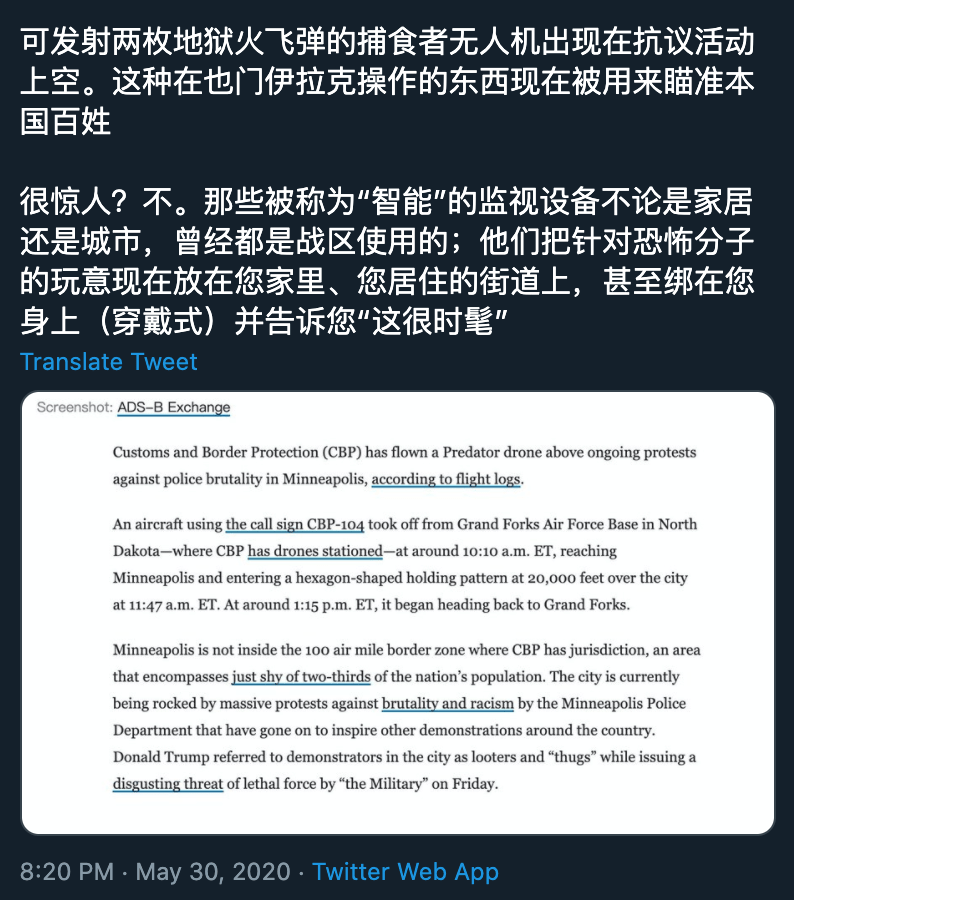
- Summary report " What surveillance methods are police using to target protesters?" 》
However, no one can say that this is unprecedented. Fast Company points out that as early as the 18th century, police have used various techniques to combat dissent—especially in communities of color.
I believe this scene will be very familiar to many people. Black and brown New Yorkers are stared at with suspicion as they walk the city's streets, and police use technology to monitor where they go and who they meet.
But at the time, the technology in this scene was not a drone or cell phone data, but a simple lantern.
As early as the 18th century, colonists worried that those they sold, imprisoned, and killed might turn against each other, so they required every slave and Native American to carry a lantern with them after dark.
They passed the oldest surveillance law in New York City in 1791, before the state had declared independence or eliminated slavery.
The lanterns became tracking beacons—a way to prevent slaves and Native Americans from coming together to fight slavery and oppression.
In the so-called policing of marginalized communities today, technology once again plays the same role it once did: Modern technology has made monitoring dissent less costly and easier .
As technology develops, so does the power of police to track and target demonstrators.
During the New York Draft Riots, government officials relied on the most advanced communications technology of the time , the telegraph, to coordinate their response, allocate police forces, and share intelligence about protest leaders.
Because the titans of the Gilded Age were so afraid of uprisings throughout the late 19th century, they not only built vast, fortress-like armories that still dot major U.S. cities to this day, but they also established tight networks of informants and surveillance , to track anyone who might rebel against the status quo.
This surveillance infrastructure was only expanded in the early 20th century, as the titans' growing fear of anarchists, socialists, and anyone other than dedicated capitalists led to the creation of new powers to monitor mail .
Under the Sedition Act of 1918 , the postmaster general has the power to prevent the delivery of any letter containing "disloyal, profane, offensive, or abusive language against the Government of the United States, the Constitution of the United States, or the military or navy of the United States."
As the 20th century dawned, the criminalization and surveillance of dissidents took another turning point: electronic communications.
Powered by wiretapping technology and state-of-the-art recording equipment at the time, police surveillance of those who dared to dissent became routine.
For the FBI, fear of "communist ties" was an excuse to wiretap and record Dr. Martin Luther King Jr. as he fought to end the terrorism of Jim Crow laws.
The tapes were never used to arrest the advocate of nonviolent peaceful resistance, but the FBI used them as a threat, along with a rude note urging Dr. King to commit suicide.
Even after wiretaps and remote surveillance cameras became commonplace in the mid-20th century, undercover police officers and informants remained central to monitoring protests on the ground .
(Note: Soon we will release a set of 3 analysis reports on how to identify authorities’ infiltration behavior , which will focus on the characteristics of undercover police officers and informants to help actors increase their vigilance)
The digital age has changed everything again. Today, police departments around the world are able to deploy a wide range of surveillance tools to track demonstrators with unprecedented precision.
Just as important, these tools make it cheap and easy to spy on more people than in earlier years.
- Demonstration of tracking protesters " How your phone betrays democracy?" 》
- Presentation (not yet released) 12 Million Phones, One Dataset: The World According to Leviathan
In modern protests, IMSI catchers (stingrays), cell phone logs, and Wi-Fi hotspots can instantly transform everyone’s mobile device into a government tracking tool. You know, the Bluetooth chip that Apple and Google claim is used as a contact tracing tool for COVID-19 prevention can also track your political activity .
- How to deal with large-scale government spying on citizens using stingrays? 》
- " Stingrays placed on planes to monitor thousands of mobile phones at once "
- " Why you shouldn't use Wi-Fi "
- " How Wi-Fi betrays you? " 》
New forms of biometric surveillance, such as facial recognition and gait recognition, can identify thousands of protesters from a single video feed.
- See here the detailed introduction list-1 "Biometric Recognition and Defense Methods"
- " China's Gait Recognition Surveillance Officially Launched: "Inspired by the United States" "
- " Learning to Walk Again: Silly Walking Fights the Rise of Gait Recognition "
And data analytics companies like Palantir, which has been condemned internationally for supporting ICE's deportation efforts, help various government agencies draw information from all of these sources, as well as one of the most powerful sources of information law enforcement has: our own social media In the account - a lot of data is collected.
- About Palantir The Evil List — Do you know these evil companies? 》 (not yet released)
- and " Will the coronavirus crisis ever end?" : The Authoritarian Trade-off " (not yet published)
- And " How the coronavirus is turning the entire planet into a dystopian hellhole — including, but not just, China: a long report " (not yet published)
In the weeks since the protests began, tens of thousands of unedited photos and videos of protesters have provided the government with a range of surveillance tools that exceed the capabilities of its own systems.
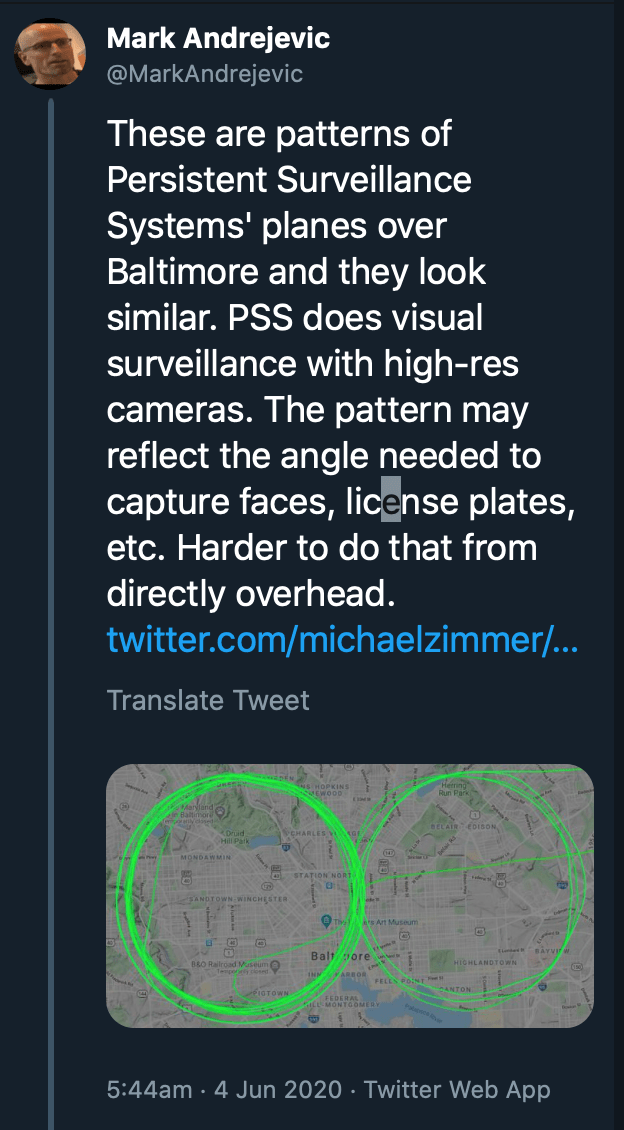
For many, these videos and images are a way to amplify the power of protest, but they can also amplify the power of police.
While tracking is nothing new, tracking on this scale is unprecedented and has the potential to undermine some of the most fundamental aspects of democracy.
When potential protesters know that every action they take will be recorded, many will be afraid to join a protest. For fear of losing their job, fear of losing their scholarship, or even losing their immigration status, many people feel like being forced into silence at the very moment when their voices are needed most.
This may be one of the reasons why Chinese immigrants have never participated in the local resistance movement.
If left unchecked, surveillance of protests will create a situation where only a privileged minority are eligible to protest. This will result in the ultimate mutation of democracy.
- do not miss it! How to Defend : Guide: When You’re Preparing to Attend a Protest…
- For more defense methods for actors , please see List-5 "Shield"
The crisis of police militarization
The military's resistance to the Trump administration's crackdown was widely circulated online in China — and was praised and admired. This is indeed good, but the military's rejection makes absolutely no sense. Why?
Because the police themselves have the military capabilities of the Pentagon .
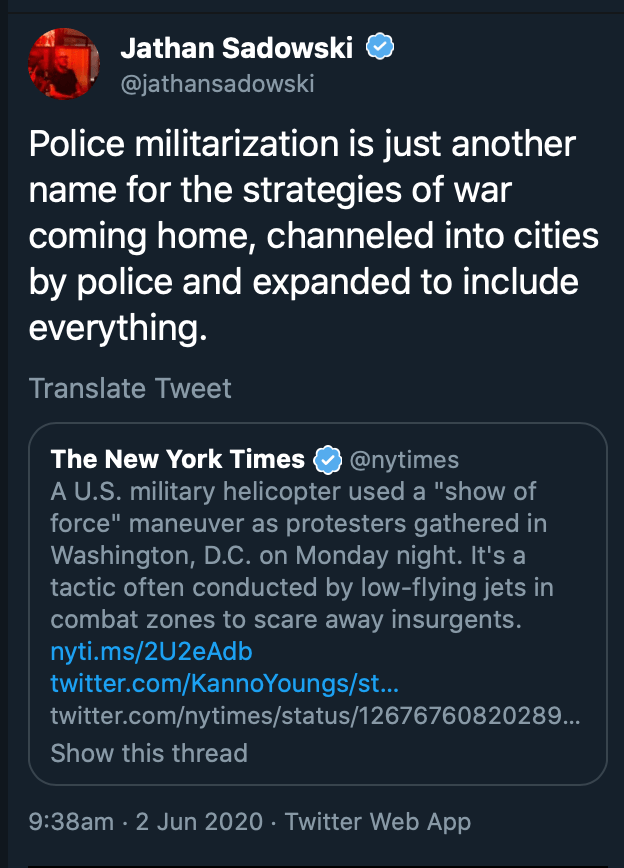
National radio commentator and author Jim Hightower elaborated on the issue of police militarization.
Americans have fought hard against having soldiers doing police work on their soil since 1776, but in recent years, Pentagon chiefs have worked with police chiefs to circumvent that ban.
How did they do it? Just militarize the police department.
Through the little-known 1033 program, the Pentagon has been shipping large amounts of surplus war equipment to local police.
This reflects a fundamental reorientation of the thinking that currently guides community policing.
Sheriffs typically send out squads wielding heavy weapons and donning riot gear to stabilize the situation.
Recruitment videos include numerous clips of SWAT officers in black uniforms throwing smoke grenades into houses and then storming in, automatic weapons drawn.
Who would want the person recruited by this video working near your home?
China also has it - just take a look, don’t vomit:
Come check out their weapons : more than 93,000 machine guns, 533 aircraft and helicopters, 180,000 cartridges, 432 mine-resistant ambush protected vehicles... Although it may sound like the US military, on the contrary, this equipment is yours The local police department patrols your city.
The police have largely been transformed into a military force, outfitted with armor, equipped with armor, and inculcated with a military mentality rather than the ethics of community policing.
Thirty years ago, Congress created the 1033 Military Material Transfer Program to provide federal grants so police chiefs and sergeants could purchase excess firepower from the Pentagon.
In an astonishingly short time, the local police force has become a majestic military force, with a lucrative arsenal of Pentagon freebies ranging from 30-ton tanks to rifle silencers .
They have gone from peacekeepers to aggressive, over-the-top SWAT teams that are released on citizens tens of thousands of times a year, doing little more than ordinary police work.
Of course, those arms dealers have jumped into direct sales, holding massive field exercises and trade shows. For example, the long-range sound cannons made by Genasys to suppress protesters are literally shocking.
And tear gas manufacturers like CTS provide tear gas and supplies to police agencies during days of protests. And of course there's the Axon stun baton (the thing that can cause cardiac arrest) that almost everyone with a police badge has on their butt these days.

Militarization is a dangerous and ultimately fatal deformation of the honorable purposes of policing that has spiraled out of control.
Most states accepted suppressors or silencers for use in covert raids . The sheriff of a North Dakota county with a population of only 11,000 told a New York Times reporter that he did not believe silencers were needed. When someone pointed out that his department had 40 divisions, he was confused, saying, "I can't remember when they were approved."
"Someone has to be the first to say 'Why are we doing this?'" a Wisconsin city councilman said when told police were buying a 9-foot-tall armored vehicle.
The New York Times reported that the town's police chief responded: "There's always the possibility of violence." Really? Who exactly threatens us so much that every place needs war zone armories and a commando mentality?
In 2015, the Obama administration banned the transfer of many military weapons and equipment to local police. It was in response to public outrage against law enforcement after Michael Brown, an unarmed black man who was killed by a white police officer in 2014 after using excessive militarized force against protesters in Ferguson, Missouri, simply ran a red light .
Yet just two years later, Donald Trump overturned Obama's ban, returning weapons of war to local police departments, including small towns, and even to school police departments across the country. These heavyweight weapons.
Now you have seen that these weapons and equipment are once again used to suppress peaceful protesters who resist police violence.
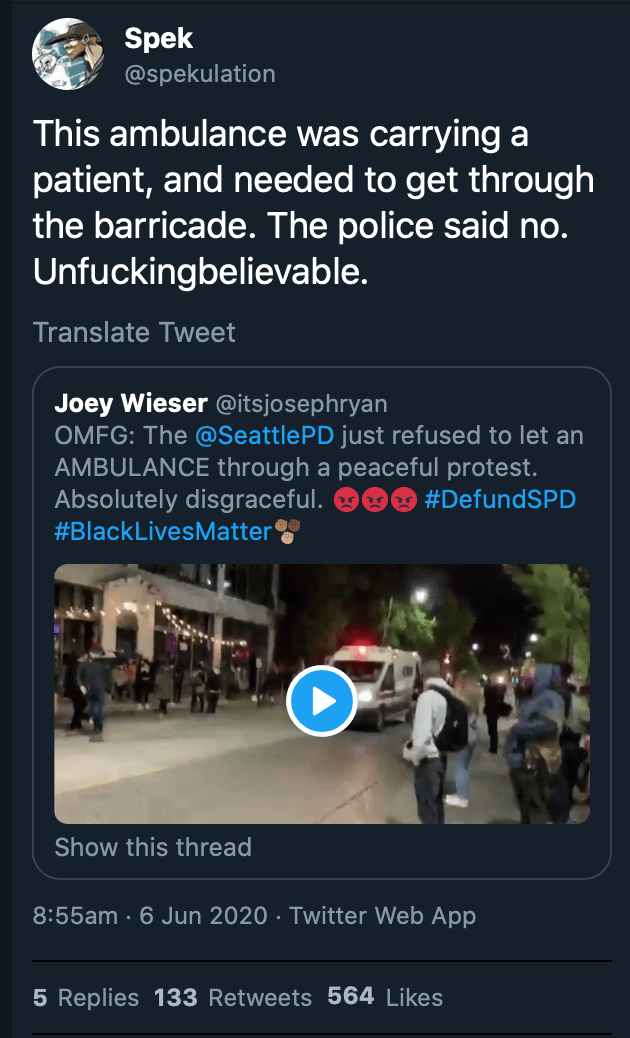
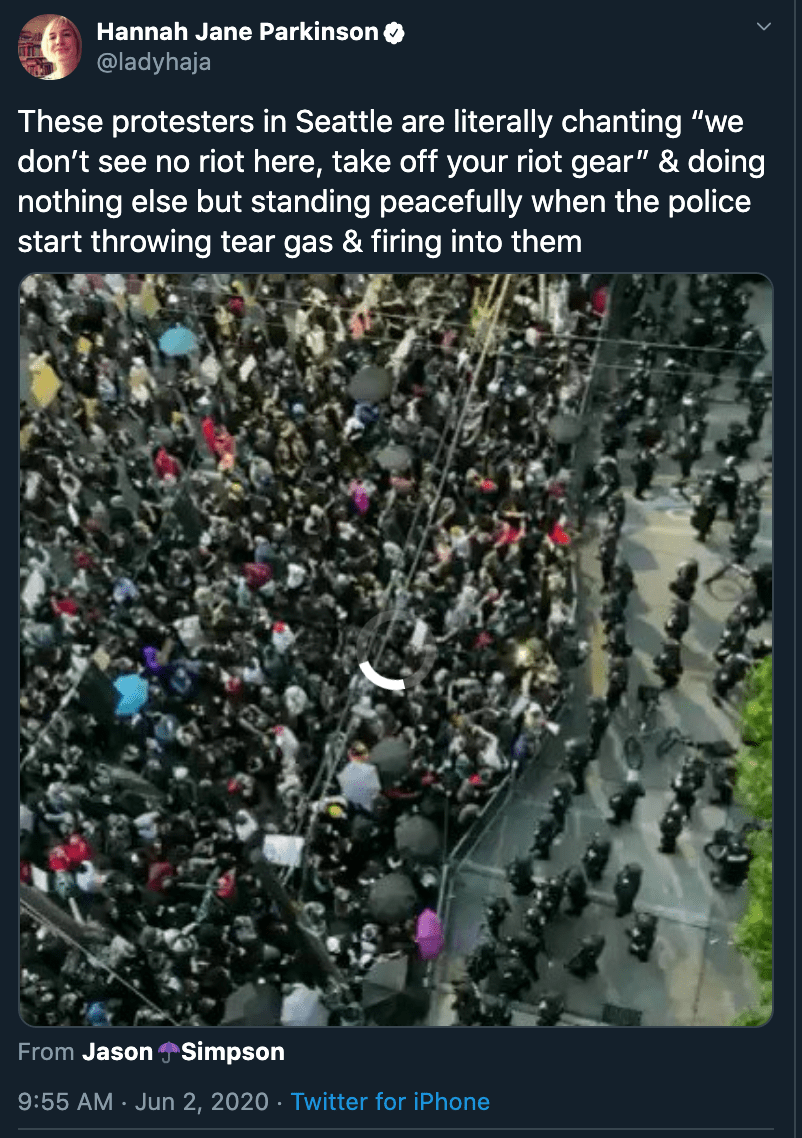
So what are the protesters facing? It's not just surveillance.
What are the protesters facing?
1. Mass arrests
At least 9,300 American civilians have been arrested for participating in nationwide protests.
The number comes from the Associated Press, which has been tracking arrests across the country.
Activist group CodePink tweeted that the fight was ongoing. "This is just the beginning. We must continue demanding #JusticeForGeorgeFloyd! #BlackLivesMatter," the group said.
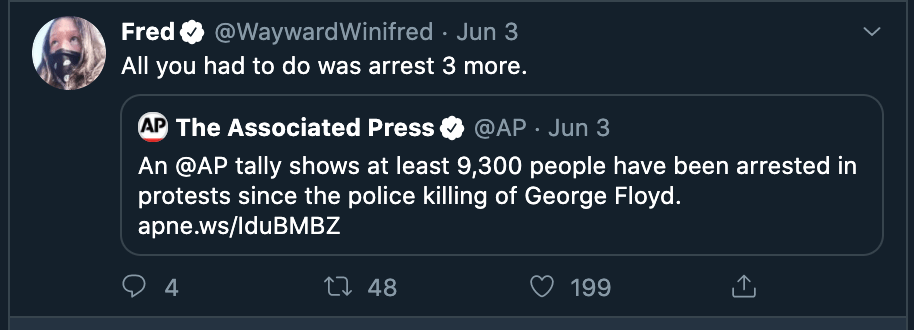
2. War simulation: espionage agencies’ military response plans for domestic resistance movements
The military's presence on the streets of major cities has been a controversial development in the face of protests by mainly young people. But this is not the first time Generation Z (those born after 1996) has appeared on the Pentagon’s stability radar.
Declassified documents obtained by The Intercept through the Freedom of Information Act reveal that a Pentagon military exercise called the 2018 Joint Land, Air, and Sea Strategic Plan (JLASS) provides a scenario in which members of Generation Z are driven by ailing status quo and dissatisfaction. Next, a protest movement called Zbellion was launched in the United States in the mid-1920s.
The military exercise was conducted by students and faculty at the U.S. War College, a training ground for future generals and admirals.
While this does not appear to be an estimate by a national intelligence agency, the military exercise "is intended to reflect a credible depiction of major trends and impacts in the world region," according to the more than 200-page document.
It describes how many members of Generation Z—who in their youth were psychologically scarred by 9/11 and the Great Recession, overwhelmed by college debt, and disillusioned with their employment options— have given up on the good. hope in life and believe the system is rigged against them.
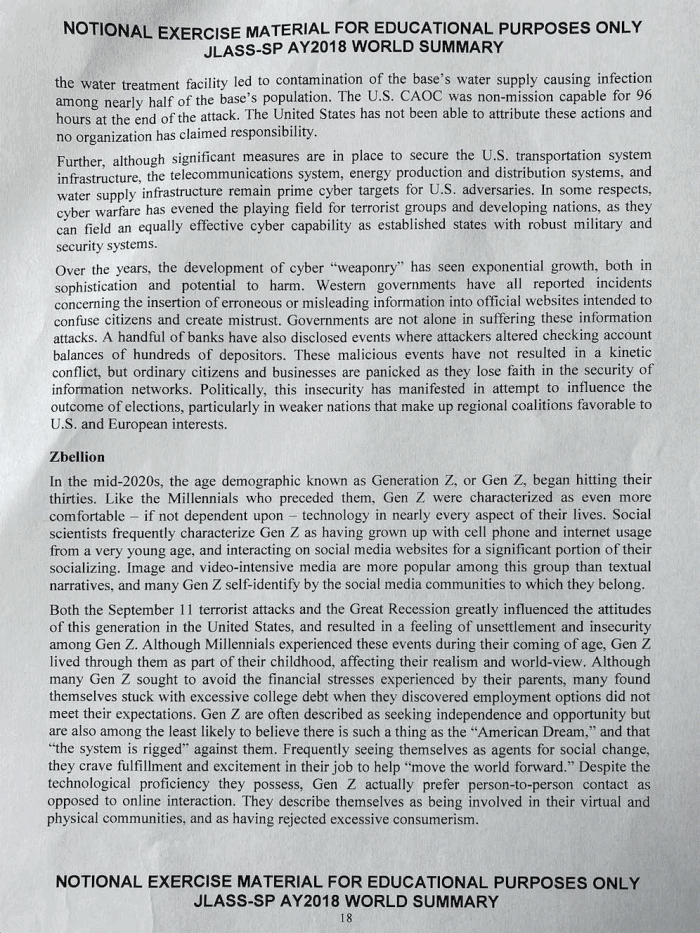
Here are the origins of the uprising described in this exercise:
Both the 9/11 terrorist attacks and the Great Recession greatly impacted this generation's attitudes toward the United States and caused Gen Z to feel unsettled and insecure, even though Millennials also experienced these events while growing up as part of their childhood. Experiencing these events has affected their realistic attitude and world view...
Many people find themselves saddled with exorbitant college debt when they realize that employment options are not meeting their expectations.
Gen Z is often described as seeking independence and opportunity, but they are also among the least likely to believe that the “American Dream” exists, believing that the “system is rigged” against them.
They often see themselves as agents of social change and desire a sense of fulfillment and excitement in their work to help "move the world forward."
Despite their technological proficiency, Gen Z actually prefers human contact over online interaction. They describe themselves as participating in their virtual and physical communities and rejecting the overconsumption of capitalism…
The story of this simulation exercise describes that in early 2025, these disaffected Generation Z people launched a protest movement. Beginning with "parks, rallies, protests and coffee shops" — first in Seattle, then New York City, Washington, D.C., Los Angeles, Las Vegas and Austin — a group called Zbellion began a "global network" movement to expose injustice and corruption and support causes it believes are beneficial.”
In face-to-face interactions, would-be Zbellion members were given instructions on how to access darknet sites that would allow them to obtain sophisticated malware in order to extract funds from companies, financial institutions, and non-profit organizations. Proceeds are then converted into Bitcoin and distributed to all "worthy recipients," including Zbellion members who claim to have financial need.
( Editor's note : This is somewhat similar to the plot of Mr. Robot, hacktivism . It turns out that the Pentagon has been preparing a stability plan for Hacktivism. Please note that the hacker technical consultant for the Mr. Robot episode is Michael Bazzell - this person serves as a full-time Law enforcement officer for more than 15 years. Currently working in the FBI's Cybercrime Task Force, primarily responsible for the collection and analysis of open source intelligence OSINT. )
In the world simulated by JLASS 2018, the most radical members of Generation Z are essentially taxing big corporations and other institutions to fight income inequality , or, in the words of a war gamer, using "the online world to spread anarchy." the call”.
The JLASS military exercise comes amid the Pentagon's controversial and visible role in ongoing domestic protests against racism and police brutality. The National Guard is already deployed in various locations, and the Trump administration has sent some active-duty military units to the Washington, D.C. area .
This comes against the backdrop of threats to use active-duty troops to forcibly suppress the protests and the deployment of rapid reaction forces from the 82nd Airborne Division to a base outside Washington, D.C.
Intercept alert : It’s worth considering how the Pentagon’s war simulations have chosen to focus the military’s attention on a generation now demonstrating their right to peaceful protest . See PENTAGON WAR GAME INCLUDES SCENARIO FOR MILITARY RESPONSE TO DOMESTIC GEN Z REBELLION here.
3. What are rubber bullets?
It is a weapon of repression against protesters. It's something that can be disabling .
People have already fully seen the power of this thing during the Yellow Vest protests. See the introduction below.
- Why are people afraid of the police? Why do police officers get so rude without any punishment? Why does the mainstream media glorify the police while ignoring over 8,000 arrests, 500 serious injuries, over 2,000 incarcerated, 12 dead, over 20 blind, 6 missing hands...? " They don't care whether you live or die because they are 1% "
- Here is a comprehensive report on stability maintenance tactics " A Glimpse of Modern Stability Maintenance Tactics "
So how are these repressive weapons used during protests in the United States? How harmful are they?
NBC reported that in addition to rubber bullets with metal cores, police also used tear gas, flash-bang grenades, pepper spray and projectiles to target the demonstrators.
The use of rubber bullets by police has stoked outrage, with images abounding on social media showing people being struck blind or seriously injured.
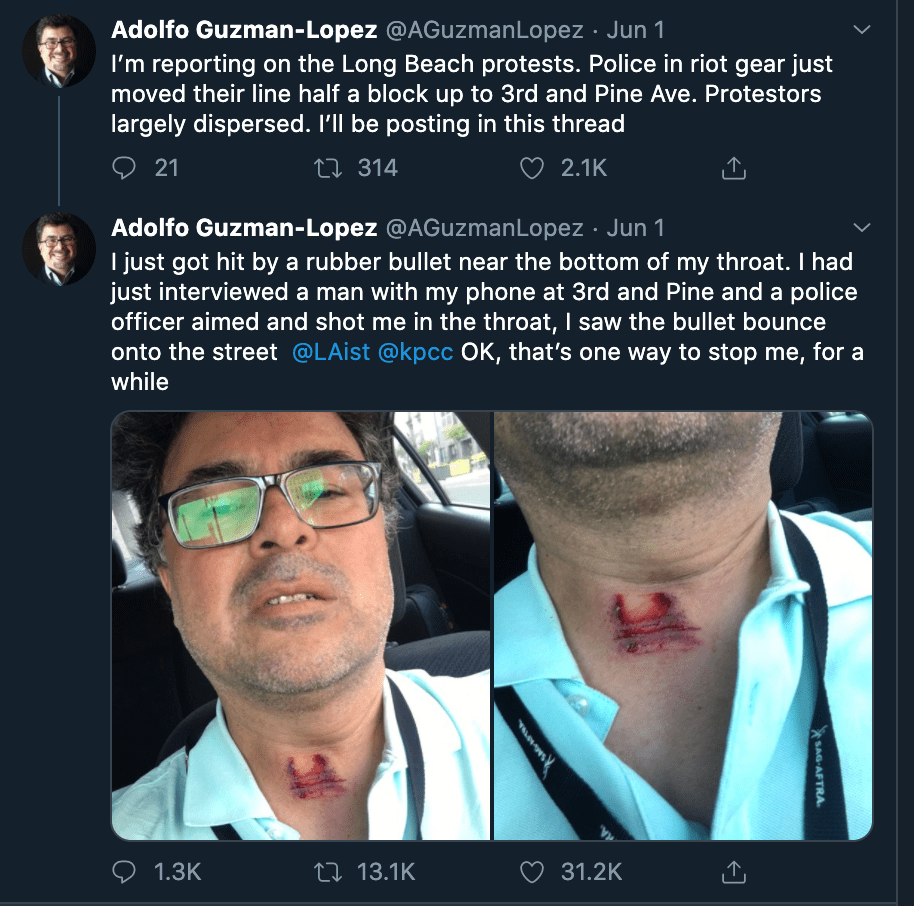
A 2017 study published in the BMJ found that 3% of people hit by rubber bullets died from their injuries. Of the 1,984 people studied, 15 percent of rubber bullet victims were permanently disabled .
Over the past week, an elderly woman in La Mesa, California, was hospitalized in the intensive care unit after being struck in the eye by a rubber bullet. Actor Kendrick Sampson says he was hit seven times by rubber bullets during a protest in Los Angeles.
In Washington, D.C., the National Guard fired rubber bullets Monday to disperse peaceful protesters near a historic church.
Attorney General William Barr defended the actions of local and federal law enforcement officers in Washington in a statement, saying they had "made significant progress in restoring order in the nation's capital."
Barr made no mention at all of the use of tear gas or rubber bullets.

Photographer Linda Tirado says she was hit in the eye by a rubber bullet during a protest in Minneapolis.
John Elder, a spokesman for the Minneapolis Police Department, said in an email response to reporters: "We use foam marker rounds up to 40 mm. We do not use rubber bullets."
Elder did not mention the brand name of the foam marker rounds used by Minneapolis police. However, the website for the Direct Impact 40mm OC Superfine Fragmentation Foam Cartridge, which describes a green, bullet-shaped product, says the weapon is "ideal whether you need to incapacitate a single target or control an entire crowd." It’s an excellent solution.”
Dr. Rohini Haar, a human rights medical expert at the University of California, Berkeley, said no one knows how often police use rubber bullets or how many people are injured each year. Many victims did not go to hospital.
Higgins, now an associate professor at John Jay College of Criminal Justice in New York, said police are not required to record the use of rubber bullets, so there is no national data on how often they are used. There are no nationally recognized standards for use .

When aimed at the legs, rubber bullets can deter a single person or a group of people from approaching police, Lazzaro said.
But when fired at close range, rubber bullets can penetrate skin, break bones, fracture skulls and pop open eyeballs, he said.
Dr. Robert Glatter, an emergency physician in New York City and spokesman for the American College of Emergency Physicians, said rubber bullets can cause traumatic brain injuries and "severe abdominal injuries, including damage to the spleen, intestines and major blood vessels."
Lazzaro said firing rubber bullets from a distance reduces their power and accuracy, increasing the risk of being shot in the face or hitting an innocent bystander.
The British army developed rubber bullets 50 years ago to control nationalist protesters in Northern Ireland, although Britain stopped using the weapons decades ago.
Israeli security forces use rubber bullets against Palestinian demonstrators.
As mentioned above, last year dozens of "yellow vest" demonstrators were blinded, hundreds were injured, and French police were criticized for their use of rubber bullets.
"Rubber bullets are used almost every day everywhere in the world. Using such weapons against unarmed civilians is a serious violation of human rights," Haar said.
Rights group Physicians for Human Rights pointed out that many police weapons that are argued to be "less lethal" can cause serious injuries.
- Sound weapons , such as cannons that emit painfully loud noises, can damage hearing.
- Tear gas can make it difficult to see or even breathe.
- Pepper spray has been used to quell recent protests and can be deadly if used incorrectly . In 2004 , a 21-year-old Boston woman died after being hit in the eye by a pepper spray shell fired by police.
- Flash-bang grenades, which produce loud noises and bright lights, can cause severe burns and explosive injuries, including damage to the eardrum. Panic crowds can cause crushing injuries.
- In cold weather, water gun spray can cause falls, stampedes, and even frostbite.
- Actions such as beating protesters with force will also hospitalize about a third of them , said Dr. Howie Mell, a spokesman for the American College of Emergency Physicians and a former tactical doctor who has worked with SWAT teams.
The New York Times also takes a good angle, reporting that the corrosive effects of tear gas could exacerbate the coronavirus pandemic.
In a paper recommended , researchers analyzed more than 1,000 protests from 1960–95 and found that police were more likely to resist police brutality and arrest people and use force more at protests than at other protests. Here " Protesting the police: anti-police brutality claims as a predictor of police repression of protest ".
——Some typical events——
1. The black owner of a barbecue restaurant was killed by an officer from the same police station where he often delivered free meals.
The Intercept reports that David McAtee's body lay in the sun on the streets of Louisville, Kentucky for more than 12 hours.
McAtee was killed by law enforcement at midnight on Sunday, May 31, as protests against police brutality continued for days across the country. McAtee's body was still dumped there at noon the next day.
McAtee was shot to death after Louisville police and the National Guard opened fire on a crowd gathered in a parking lot.
David McAtee, 53 , is considered a "community pillar", partly due to the popularity of his Yaya's BBQ restaurant. McAtee, who has been in business for decades , often provides free meals to traveling police officers .
Onlookers and witnesses said the crowd did not protest when police arrived.
Activists said the crowd, made up mostly of community members rather than seasoned radical activists, was angry and hurt. "We are dealing with the death of Breonna Taylor," he said. He was referring to a young black woman shot and killed by police two months ago.

2. People who are not on the streets are also arrested and questioned about their political opinions
Joel Feingold was in his Brooklyn apartment on Wednesday night when he heard police beating protesters outside the building.
Feingold rushed outside. A senior New York City police officer quickly threw him to the ground, piled him into a police car, and arrested him along with four others for "ostensibly violating the curfew recently imposed on New York City residents."
Feingold and others were taken to the NYPD and told they were being held for violating the city's 8 p.m. curfew. There, they were questioned by the NYPD and FBI about their political beliefs and reasons for participating in nationwide protests, Feingold told reporters.
Feingold said the FBI agents' questioning apparently focused on his political views.
Two kinds of public opinion
1. Polls show majority of Americans support protesters
A majority of Americans believe protesters' anger and at least some of their actions are justified, according to new polls from across the country.
The poll also found that a majority of Americans believe police use a disproportionate amount of force against black people compared to white people, an increase from four years ago when only one-third of the public held that view.
Patrick Murray, director of the independent Monmouth University Polling Institute, said in a statement: "It appears we have reached a tipping point in public opinion where white Americans have realized that African Americans face greater consequences when interacting with the police. Big risk. They may not agree with some of the violence seen in recent protests, but many white people say they understand the source of the anger."
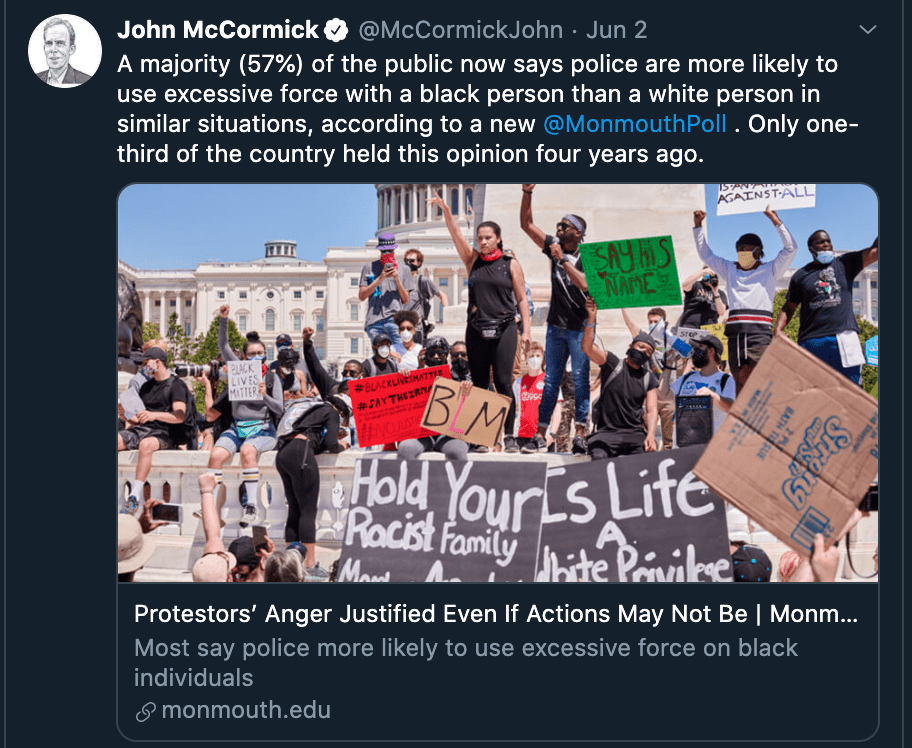
Polls from Monmouth, Reuters/Ipsos , and CBS/YouGov all found that, for the first time, major majorities believe police disproportionately target black people . The number of white people who believe police use excessive force more often against black people has doubled since 2016.

In particular, Monmouth found that a majority of Americans believed that demonstrators participating in uprisings against police violence and brutality were justified and that their actions were fully or partially justified.

As Monmouth said:
17% of the public said the actions of protesters, including the burning of police zones in response to the killing of George Floyd by Minneapolis police officers, were completely justified, while a further 37% said these actions is partially reasonable.
A majority of Americans (57%) say the anger leading to these protests is completely justified.
Another 21% thought it was partially justified, and only 18% thought it was unreasonable.
Forum News columnist Rob Port tweeted that the 17% number is bigger than it seems:
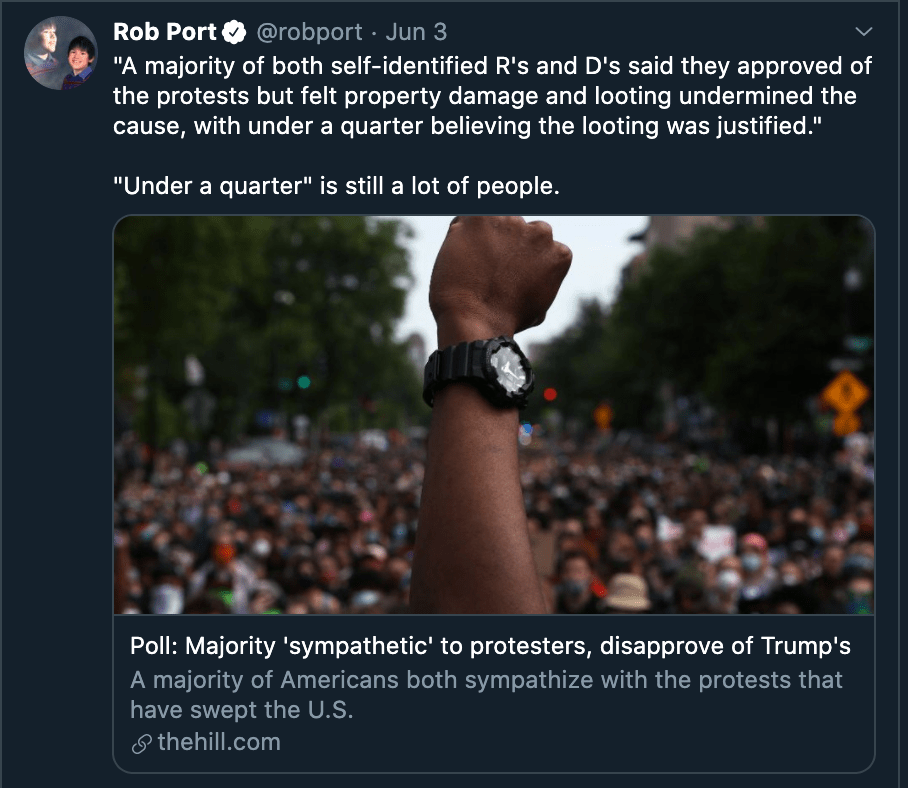
2. Chinese public opinion
The picture below was circulated on the Chinese Internet and praised as "wise public opinion"...

Apart from the partial analysis of Chinese society mentioned above, other comments are omitted here.
alliance
At the beginning of this protest movement, IYP expressed the hope that Chinese activists could learn from it.
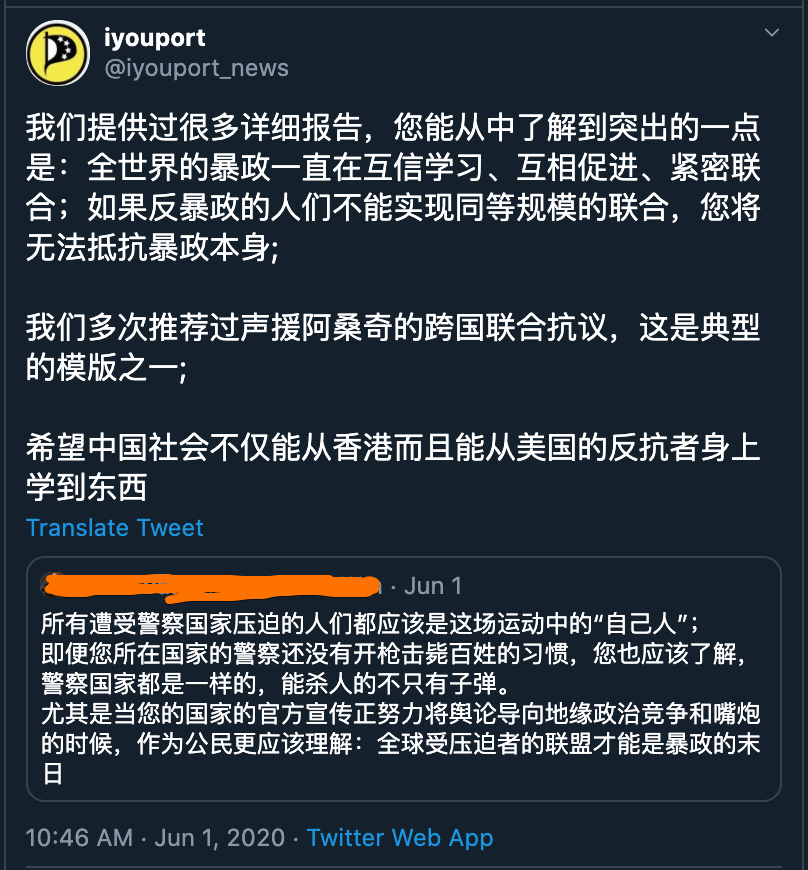
Soon thereafter, many countries around the world caught up with the movement. Here are some brief introductions.
——To be continued——
Like my work? Don't forget to support and clap, let me know that you are with me on the road of creation. Keep this enthusiasm together!

- Author
- More